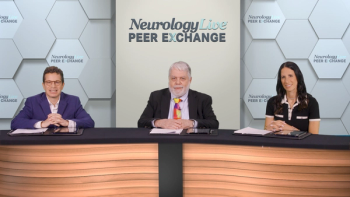
Amantadine DR/ER for Dyskinesia in Parkinson Disease: Safety Profile and Ideal Patient
The expert panel reviews the safety profile of amantadine DR/ER and who may be an ideal patient for its use in patients with Parkinson disease experiencing dyskinesia.
Episodes in this series

Daniel E. Kremens, MD, JD: I should point out that we’re talking about all the great things about this drug, and I think for most of us, our experience is that patients have done really well. But there were several common adverse events in the studies including dry mouth, nausea, decreased appetite, insomnia, orthostatic hypotension, hallucinations, and, I think, peripheral edema as well. It’s important that we note those things, and with that in mind, I’d like to open up to the panel. We now have a fair amount of experience using amantadine DR/ER in the clinic to help manage both dyskinesia and “off”. So who would you identify? Do you think there’s an ideal candidate for this drug, or what are your thoughts on that?
Rajesh Pahwa, MD: Before we go to that, let’s talk a little bit about the safety, because a lot of people have concerns about the safety of amantadine, especially DR/ER, and I think people need to realize amantadine and renal function is very important. When we did the clinical trials, these patients had GFR [globular filtration rate] of greater than 60. The majority of our elderly patients have GFR of less than 60. If that’s the case, the patient should be started only on 68.5 mg, not the higher dose, and they should definitely not go to the 274 mg.
Daniel E. Kremens, MD, JD: For people who aren’t familiar, the doses that are available are 68.5, 137 milligrams and 274 milligrams, taken as two 137-mg capsules at bedtime. The recommended starting dose for people without renal impairment is 137 mg at bedtime for 1 week and then increasing to 274 mg.
Rajesh Pahwa, MD: That’s correct. In people who have GFR of less than 60, they should start at 68.5 mg and go to 137 mg, and not go any higher. The adverse effects are important, but it’s also important that everyone should not go to the maximum dose because that we can show that it may reduce the adverse effects from the amantadine-DR/ER.
Daniel E. Kremens, MD, JD: In my clinical practice, because I’m not checking renal function on every patient, if the patient is over 70, statistically, they have a higher likelihood of undiagnosed renal impairment. I’ll typically start that patient at 68.5 mg and see how they do, rather than start them at 137 mg. That’s my clinical practice. In the label, it would say that you would start the patient at 137 mg.
Rajesh Pahwa, MD: I agree. I think that’s what needs to be done in patients after a certain age, like 70, they should be started at a lower dose. That’s all I wanted to point out about the safety.
Daniel E. Kremens, MD, JD: Who’s the ideal patient for DR/ER? Any thoughts on that, panel?
Fernando Pagan, MD: In my clinical practice, the ideal patient is a patient who’s having motor fluctuations or having dyskinesia, having off time. I’ve tried all these other formulations, all these adjunct therapies, and I haven’t been successful. I will tell them about this particular medicine that is available, that it’s only once at night, that they can take it, and I’ll slowly start them up. I agree that younger patients who are having these fluctuations, I don’t have a problem starting, just like they did in the clinical trials, at 137 mg at nighttime and then after a week go up to the 274 mg, the 2 capsules of the 137 mg. If they’re above the age of 70, you start at 68.5 mg, and you slowly go up from there. I’ve had some 70-, 72-year-olds able to tolerate the 274 mg dose, but again, I take my time to get up there. I think the ideal patient is someone who is having a lot of problems with dyskinesia and their quality of life, and it’s impacting them, and they’re having that off period. I tell them about this data, about being able to reduce the off time. When we look at any oral therapy out there, we can reduce that off time by 1 hour. We can reduce the dyskinesia by about 40%, and we can give an additional 2.6 hours of “on” time without troublesome dyskinesia. That’s as best as you can do for an oral therapy without going to DBS [deep brain stimulation]. The only thing that beats that is deep brain stimulation. So for these patients, I may be thinking about deep brain stimulation; I may try this first before going to DBS. This is something I talk about in my clinical practice to our patients who are having significant off and dyskinesia.
Rajesh Pahwa, MD: Yes, patients who have dyskinesia are candidates, patients who have off are candidates, but if you told me to pick the one who is the best, I would say it’s anyone with off who’s beginning to have dyskinesia because that is the one we need to catch…before the dyskinesia gets worse because this patient is having off. We know if we add an adjunctive therapy, the dyskinesia will get worse, so why not treat this patient with both before they get to the point that the dyskinesia is troublesome. I’m not saying we shouldn’t treat the ones who have troublesome symptoms, but that’s the patient I would start at right away.
Daniel E. Kremens, MD, JD: I agree, Raj. Now that I have a drug that can treat both dyskinesia and off, I’m able to use it much earlier in the disease course because in the past, if you saw a patient who was complaining about off, but they had a little bit of dyskinesia, you were always in this position: OK, what am I going to do? If I treat the off, then he’s going to come back and tell me his dyskinesia is worse. So for me, it can be the first adjunctive therapy you add to someone because we’ve already talked about how some people, even early on in disease, just on levodopa, have developed dyskinesia. I don’t have to try a million adjunctive therapies and try to balance their dyskinesia and their off. Now I have a way to finally do both relatively early on in the disease state. Of course, any patient with dyskinesia, I think that it’s certainly a good choice for them. The one thing that we have to keep in mind is the safety profile. So obviously, someone with impaired renal function, we’re going to be careful about that; with someone who’s actively psychotic, amantadine is probably not a good choice; with someone who already has some peripheral edema, they probably want to be a little careful in that patient about adding it. I want to comment briefly on the hallucinations because hallucinations were the most common adverse events seen in the clinical trial, occurring in about 20% of people, but what we also saw was that this occurred much more in the elderly population in the studies, and the vast majority of the hallucinations resolved with either dose adjustment or discontinuation of the medication.
Rajesh Pahwa, MD: I think we should mention livedo reticularis, the skin issue that some patients have. In the DR/ER study there was a very small number of affected patients. The other thing is that this is a harmless adverse effect. Yes, it colors the skin, it’s a cosmetic issue, but it is not something that would be considered dangerous for the patient.
Fernando Pagan, MD: I was just going say that in my clinical practice, I have seen hallucinations, but in the majority of the patients, it’s been transient. I often teach my residents and fellows that in one of my earlier uses with this drug, I had a patient who had an auditory hallucination, but it lasted only 1 day. They’ve been probably one of the most successful patients that I’ve had treated with DR/ER. So sometimes you don’t have to make a change right away, or if you see that, you come down on the dosing and you may see those hallucinations go away. It is something that is seen in clinical practice, but sometimes if you wait a little bit, you will see some of those patients resolve.
Robert A. Hauser, MD, MBA: I just want to add to what Fernando said. One of the analyses we did and published was of patients who were potential candidates for device aid therapies and DBS, according to 5-2-1 criteria, which is at least 5 levodopa doses per day, at least 2 hours of off time per day, and at least 1 hour of dyskinesia per day; so, really, surgical candidates. We saw an increase in good on time without troublesome dyskinesia, in the ballpark of what patients get with DBS, so we think that in patients who have a good safety profile, patients who have low risk for hallucinations, it makes sense to do at least a trial of amantadine DR/ER before going to surgery. I also agree with what you and Raj were saying about patients who have off time with some dyskinesia. Those are good candidates too. I just think, Dan, when you say ideal candidate, probably the younger and those with a lower risk for hallucination are the more ideal, but that doesn’t mean that older patients can’t tolerate it, especially if they don’t have any history of hallucinations and have good cognitive function.
Daniel E. Kremens, MD, JD: Bill, do you want to comment on your clinical experience?
William G. Ondo, MD: Yeah, I think it’s similar. If someone is actively psychotic or very high risk for psychosis, it would give me some pause to use this medication, but otherwise, I think the indications for it are, especially if they have off time and dyskinesia, there’s nothing else FDA approved for that. I mention one other thing about the livedo reticularis. It’s a common adverse effect with chronic use; usually by 6 months to a year is when people get this. It’s something I always warn them about, because it is a benign adverse event, but I’ve seen patients who have had these enormous rheumatologic evaluations and subsequent diagnoses because of livedo reticularis, so it is a fairly specific thing for amantadine. To my knowledge, I don’t know the pathogenesis of that common long-term adverse effect of the drug.
Transcript Edited for Clarity
Newsletter
Keep your finger on the pulse of neurology—subscribe to NeurologyLive for expert interviews, new data, and breakthrough treatment updates.








































